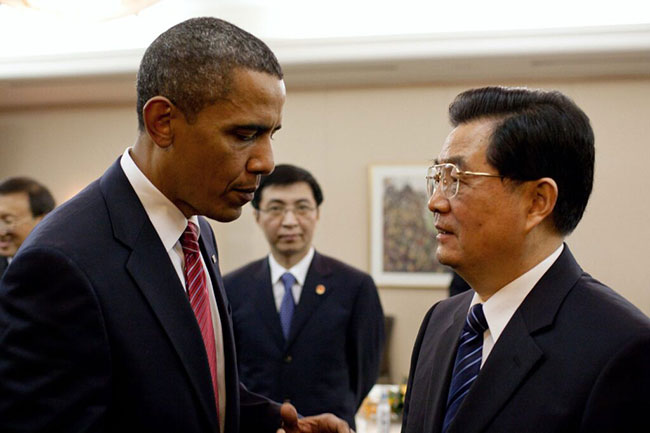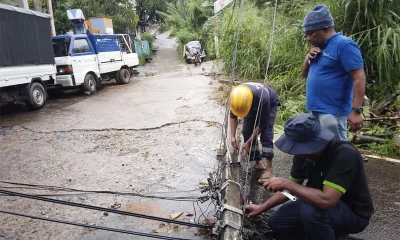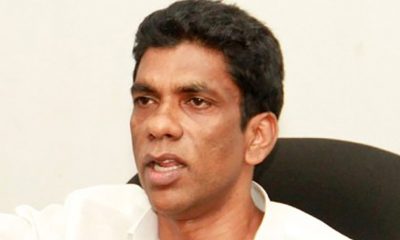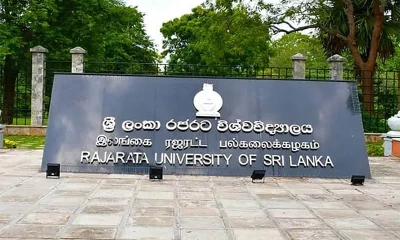Features
Wang Huning: A Communist Mandarin

by Kumar David
Wan Huning is an exceptionally brilliant individual or so says N. S. Lyons in a piece on October 11, in the website Palladium. No surprise in a nation of 1.4 billion souls.
Wang represents a school of communist theoreticians underpinning the ideological continuity of Chinese Communist political-economy as it evolved from the Deng era. Jiang Zemin first spotted Wang, who then worked through the presidencies of jellyfish Jiang and apparatchik Hu Jintao to the now powerful Xi Jinping. He is currently the CCP’s top theoretician and lead-ideologist behind Party ‘thought’. He is in the seven-member Standing Committee of the Politburo and unofficially ranked fifth in precedence. Surprisingly, little has been written about him; even in China, he remains an enigma. Though he has authored 20 books, they have not been much discussed and a Chinese language web search threw up little useful information.
To use Lyons’ imagery, Wang and his theoretical cognoscenti constitute an unobtrusive party Machiavelli-cluster standing behind the throne and making sure the emperor does as he is told. Did the ambitions Zhu Rongji, Jiang Zemin’s “capitalist roader” finance minister, have the approval of party theoreticians at that stage in China’s politico-economic transition, or were there factional tensions? I think the latter; divergent theoretical-ideological factions are unavoidable in a huge entity like the CPC (80 million strong) and this implies tensions. At present however Wang-theory, for want of a better term, has come to the helm.
My columns are fact-and-theory laden and boring to read. I will quit droning and try this time at least to make it more people oriented. But old habits die hard, so I need to summarise my perception of Chinese political-economy before getting down to the readable bits. If you had the misfortune to read my September 26 piece ‘Category-5 Typhoon in China,’ you can breathe a sigh of relief and skip the five following bullet points.
 * China is not a capitalist state in any rational sense that the term capitalism can be used.
* China is not a capitalist state in any rational sense that the term capitalism can be used.
* The Deng Xiaoping “revolution” was the use of market mechanisms and capitalism as tools, side by side with state direction, to achieve economic growth. The strategy was successful beyond expectation and China became a vibrant economy and a powerful nation; in the process a rich capitalist class emerged.
* Power remained in the hands of the CPC, unchallenged at all times; the emerging capitalist class could never contest the hegemony of the Party. The CPC core and the nouveau-riche capitalist class, by and large, inhabited different spheres.
* Authoritarianism was the bedrock method of political control.
* In late 2020 and in 2021 the CPC initiated a sharp course correction which is ongoing. The changes consist of: (a) Greater state direction of the economy, (b) reining in the big tech-sector, finance-capital and limiting foreign listings, (c) greater government intervention and scrutiny of companies, (d) tighter regulation of culture-stuff such as Star-Personalities and cleaning TV shows of “undesirable” content, (d) supervising internet access and access to foreign sites, (e) greater control of educational content and opportunities, and (e) enhanced tightening in Hong Kong and Xinjiang.
Wang, who is 66 years old, has an intensely intellectual personality. “Wang Huning is arguably the single most influential public intellectual alive today”, says Lyon, and I think he means not just in China but in the world. (Quotes from Lyon’s article are marked [L] hereafter). Wang’s official title is First Secretary of the Central Secretariat of the Communist Party; previously from 2002 to 2020 he was Director of the Central Policy Research Office of the Party. His books include Logic of Politics – Principles of Marxism, and America against America, the latter written after six months touring the US in 1988 as a visiting professor when he became disillusioned that the country was tearing itself apart. To see this in 1988 was certainly prescient, maybe prophetic. “While Americans perceive that they face intricate social and cultural problems, they think of these as scientific and technological issues to be solved separately. This gets them nowhere; their problems are inextricably interlinked and have the same root cause; a radical, nihilistic individualism at the heart of modern American liberalism”: [L]. I doubt if any of his books are available in English, leaving me dependent on obliging Chinese friends.
One quote from Wang is such a striking a reminder of Marx’s concept of alienation that I was stunned to have it from a CPC Politburo member. “The real cell of society in the United States is the individual. The cell foundational as per Aristotle, the family, has disintegrated. Everything has a dual nature, the glamour of commodification abounds; human flesh, sex, knowledge, politics, power, and the law are targets of commodification. The system has created loneliness as its innermost product, along with spectacular inequality. Nihilism has become the American way, a fatal shock to cultural development and the American spirit”; [L]. Elsewhere Wang breaks with orthodox Stalinist-materialism and asserts that social values and culture too are crucial in social and historical dynamics. He is clearly a disciple of the 18th Brumaire and the Civil War in France.
Wang argues that “China has to resist the global liberal sway and be culturally unified, self-confident and led by a strong, centralized party-state. He reflects a desire to blend Marxism with traditional Confucianism to synthesise a foundation for long-term stability” [L]. This is in line with a CPC precept that a strong central state was needed to unify the country. In this he found an influential ally in Xi Jinping who in any case had no option but to rein in nihilistic bourgeois-liberalism, be wary of alien Western culture and take harsh measures against the scourge of corruption. The Party, opportunely, is in the serendipitous position that what it has to do for material success, for social cohesion, and to consolidate its own power have come neatly into congruence.
The immense success of market-reforms have transformed China into a high income (for some) and at the same time an unequal income, unequal opportunity society. [See Technical Note below]. The richest 1% hogs a third of the country’s non-state-owned wealth. Though grinding poverty has been wiped out, most rural folk survive only moderately above subsistence and city employees toil for up to 72 hours a week and earn less than workers in the West. Competition for education and housing is intense, medical care is poor. Individualism is rising as a bogus substitute for genuine liberalism. The 2020-21 course-correction, identified with Xi Jinping, no doubt sprang from within the Party’s ideological core which was alarmed by these trends.
Apart from mass social pressures to which the Party is always sensitive, there was a threat of an imbalance in the power-structure that an assertive capitalist class could have provoked. Above this was competition with America for global hegemony. Chinese capitalism is nowhere near strong enough to compete against the deep pockets, sophistication and experience of American capitalism, or to take forward the Belt & Road Initiative sans the state taking the leading role. The BRI is a state-led initiative – for example the multi-billion dollar railway from China to Europe. The contours of the where and the why of the course correction and the reasons for the Party’s bold assertion of hegemony are clear.
There is however an ineluctable tension in Wang Hunning’s conceptual constructions. Can society leap from the “domain of necessity to the domain of freedom”, or in less grandiose words from the crassness of consumerism and nihilist individualised liberalism, to a higher civilisation as the literati call it, sans transition via a free and democratic polity? Can society leap-frog from authoritarianism, over everyday freedoms, to socialism? The logical answer is NO.
At this time only two nations-societies are paradigms; only two will be influential global models or archetypes. (Whether China’s state-led economic strategy is a better economic track for backward countries is, in comparison, a separate question of trivial dimensions). In the post-WW2 period there were two global paradigms, capitalism sometimes with liberal features (numerous copies) and variations on the Soviet model (Eastern Europe, Maoist China, Cuba and a few others). At the present time I am inclined to the view that my instinct expressed last week (‘United States and Social Democracy’) that the US, with both extraordinary wealth and everyday albeit flawed democracy peeping through the crooked legs of rumbustious populism, is in pole position. Of course this is predicated on the expectation that the visible drift to increasing social-democracy, not some Trump-style malady will profile the USA of posterity.
Technical Note: Everyone’s income and social inequality can increase simultaneously! Consider A, B and C with incomes of 5, 10 and 15 respectively. The mean is 10 and the largest disparity is 10 (15 minus 5). Suppose A, B and C double to 10, 20 and 30. Everybody gets more, the average has risen to 20 and at the same time inequality has increased from 10 to 20 (30 minus 10). The trick is a generalised increase in incomes.
Features
Disaster-proofing paradise: Sri Lanka’s new path to global resilience

iyadasa Advisor to the Ministry of Science & Technology and a Board of Directors of Sri Lanka Atomic Energy Regulatory Council A value chain management consultant to www.vivonta.lk
As climate shocks multiply worldwide from unseasonal droughts and flash floods to cyclones that now carry unpredictable fury Sri Lanka, long known for its lush biodiversity and heritage, stands at a crossroads. We can either remain locked in a reactive cycle of warnings and recovery, or boldly transform into the world’s first disaster-proof tropical nation — a secure haven for citizens and a trusted destination for global travelers.
The Presidential declaration to transition within one year from a limited, rainfall-and-cyclone-dependent warning system to a full-spectrum, science-enabled resilience model is not only historic — it’s urgent. This policy shift marks the beginning of a new era: one where nature, technology, ancient wisdom, and community preparedness work in harmony to protect every Sri Lankan village and every visiting tourist.
The Current System’s Fatal Gaps
Today, Sri Lanka’s disaster management system is dangerously underpowered for the accelerating climate era. Our primary reliance is on monsoon rainfall tracking and cyclone alerts — helpful, but inadequate in the face of multi-hazard threats such as flash floods, landslides, droughts, lightning storms, and urban inundation.
Institutions are fragmented; responsibilities crisscross between agencies, often with unclear mandates and slow decision cycles. Community-level preparedness is minimal — nearly half of households lack basic knowledge on what to do when a disaster strikes. Infrastructure in key regions is outdated, with urban drains, tank sluices, and bunds built for rainfall patterns of the 1960s, not today’s intense cloudbursts or sea-level rise.
Critically, Sri Lanka is not yet integrated with global planetary systems — solar winds, El Niño cycles, Indian Ocean Dipole shifts — despite clear evidence that these invisible climate forces shape our rainfall, storm intensity, and drought rhythms. Worse, we have lost touch with our ancestral systems of environmental management — from tank cascades to forest sanctuaries — that sustained this island for over two millennia.
This system, in short, is outdated, siloed, and reactive. And it must change.
A New Vision for Disaster-Proof Sri Lanka
Under the new policy shift, Sri Lanka will adopt a complete resilience architecture that transforms climate disaster prevention into a national development strategy. This system rests on five interlinked pillars:
Science and Predictive Intelligence
We will move beyond surface-level forecasting. A new national climate intelligence platform will integrate:
AI-driven pattern recognition of rainfall and flood events
Global data from solar activity, ocean oscillations (ENSO, MJO, IOD)
High-resolution digital twins of floodplains and cities
Real-time satellite feeds on cyclone trajectory and ocean heat
The adverse impacts of global warming—such as sea-level rise, the proliferation of pests and diseases affecting human health and food production, and the change of functionality of chlorophyll—must be systematically captured, rigorously analysed, and addressed through proactive, advance decision-making.
This fusion of local and global data will allow days to weeks of anticipatory action, rather than hours of late alerts.
Advanced Technology and Early Warning Infrastructure
Cell-broadcast alerts in all three national languages, expanded weather radar, flood-sensing drones, and tsunami-resilient siren networks will be deployed. Community-level sensors in key river basins and tanks will monitor and report in real-time. Infrastructure projects will now embed climate-risk metrics — from cyclone-proof buildings to sea-level-ready roads.
Governance Overhaul
A new centralised authority — Sri Lanka Climate & Earth Systems Resilience Authority — will consolidate environmental, meteorological, Geological, hydrological, and disaster functions. It will report directly to the Cabinet with a real-time national dashboard. District Disaster Units will be upgraded with GN-level digital coordination. Climate literacy will be declared a national priority.
People Power and Community Preparedness
We will train 25,000 village-level disaster wardens and first responders. Schools will run annual drills for floods, cyclones, tsunamis and landslides. Every community will map its local hazard zones and co-create its own resilience plan. A national climate citizenship programme will reward youth and civil organisations contributing to early warning systems, reforestation (riverbank, slopy land and catchment areas) , or tech solutions.
Reviving Ancient Ecological Wisdom
Sri Lanka’s ancestors engineered tank cascades that regulated floods, stored water, and cooled microclimates. Forest belts protected valleys; sacred groves were biodiversity reservoirs. This policy revives those systems:
Restoring 10,000 hectares of tank ecosystems
Conserving coastal mangroves and reintroducing stone spillways
Integrating traditional seasonal calendars with AI forecasts
Recognising Vedda knowledge of climate shifts as part of national risk strategy
Our past and future must align, or both will be lost.
A Global Destination for Resilient Tourism
Climate-conscious travelers increasingly seek safe, secure, and sustainable destinations. Under this policy, Sri Lanka will position itself as the world’s first “climate-safe sanctuary island” — a place where:
Resorts are cyclone- and tsunami-resilient
Tourists receive live hazard updates via mobile apps
World Heritage Sites are protected by environmental buffers
Visitors can witness tank restoration, ancient climate engineering, and modern AI in action
Sri Lanka will invite scientists, startups, and resilience investors to join our innovation ecosystem — building eco-tourism that’s disaster-proof by design.
Resilience as a National Identity
This shift is not just about floods or cyclones. It is about redefining our identity. To be Sri Lankan must mean to live in harmony with nature and to be ready for its changes. Our ancestors did it. The science now supports it. The time has come.
Let us turn Sri Lanka into the world’s first climate-resilient heritage island — where ancient wisdom meets cutting-edge science, and every citizen stands protected under one shield: a disaster-proof nation.
Features
The minstrel monk and Rafiki the old mandrill in The Lion King – I

Why is national identity so important for a people? AI provides us with an answer worth understanding critically (Caveat: Even AI wisdom should be subjected to the Buddha’s advice to the young Kalamas):
‘A strong sense of identity is crucial for a people as it fosters belonging, builds self-worth, guides behaviour, and provides resilience, allowing individuals to feel connected, make meaningful choices aligned with their values, and maintain mental well-being even amidst societal changes or challenges, acting as a foundation for individual and collective strength. It defines “who we are” culturally and personally, driving shared narratives, pride, political action, and healthier relationships by grounding people in common values, traditions, and a sense of purpose.’
Ethnic Sinhalese who form about 75% of the Sri Lankan population have such a unique identity secured by the binding medium of their Buddhist faith. It is significant that 93% of them still remain Buddhist (according to 2024 statistics/wikipedia), professing Theravada Buddhism, after four and a half centuries of coercive Christianising European occupation that ended in 1948. The Sinhalese are a unique ancient island people with a 2500 year long recorded history, their own language and country, and their deeply evolved Buddhist cultural identity.
Buddhism can be defined, rather paradoxically, as a non-religious religion, an eminently practical ethical-philosophy based on mind cultivation, wisdom and universal compassion. It is an ethico-spiritual value system that prioritises human reason and unaided (i.e., unassisted by any divine or supernatural intervention) escape from suffering through self-realisation. Sri Lanka’s benignly dominant Buddhist socio-cultural background naturally allows unrestricted freedom of religion, belief or non-belief for all its citizens, and makes the country a safe spiritual haven for them. The island’s Buddha Sasana (Dispensation of the Buddha) is the inalienable civilisational treasure that our ancestors of two and a half millennia have bequeathed to us. It is this enduring basis of our identity as a nation which bestows on us the personal and societal benefits of inestimable value mentioned in the AI summary given at the beginning of this essay.
It was this inherent national identity that the Sri Lankan contestant at the 72nd Miss World 2025 pageant held in Hyderabad, India, in May last year, Anudi Gunasekera, proudly showcased before the world, during her initial self-introduction. She started off with a verse from the Dhammapada (a Pali Buddhist text), which she explained as meaning “Refrain from all evil and cultivate good”. She declared, “And I believe that’s my purpose in life”. Anudi also mentioned that Sri Lanka had gone through a lot “from conflicts to natural disasters, pandemics, economic crises….”, adding, “and yet, my people remain hopeful, strong, and resilient….”.
“Ayubowan! I am Anudi Gunasekera from Sri Lanka. It is with immense pride that I represent my Motherland, a nation of resilience, timeless beauty, and a proud history, Sri Lanka.
“I come from Anuradhapura, Sri Lanka’s first capital, and UNESCO World Heritage site, with its history and its legacy of sacred monuments and stupas…….”.
The “inspiring words” that Anudi quoted are from the Dhammapada (Verse 183), which runs, in English translation: “To avoid all evil/To cultivate good/and to cleanse one’s mind -/this is the teaching of the Buddhas”. That verse is so significant because it defines the basic ‘teaching of the Buddhas’ (i.e., Buddha Sasana; this is how Walpole Rahula Thera defines Buddha Sasana in his celebrated introduction to Buddhism ‘What the Buddha Taught’ first published in1959).
Twenty-five year old Anudi Gunasekera is an alumna of the University of Kelaniya, where she earned a bachelor’s degree in International Studies. She is planning to do a Master’s in the same field. Her ambition is to join the foreign service in Sri Lanka. Gen Z’er Anudi is already actively engaged in social service. The Saheli Foundation is her own initiative launched to address period poverty (i.e., lack of access to proper sanitation facilities, hygiene and health education, etc.) especially among women and post-puberty girls of low-income classes in rural and urban Sri Lanka.
Young Anudi is primarily inspired by her patriotic devotion to ‘my Motherland, a nation of resilience, timeless beauty, and a proud history, Sri Lanka’. In post-independence Sri Lanka, thousands of young men and women of her age have constantly dedicated themselves, oftentimes making the supreme sacrifice, motivated by a sense of national identity, by the thought ‘This is our beloved Motherland, these are our beloved people’.
The rescue and recovery of Sri Lanka from the evil aftermath of a decade of subversive ‘Aragalaya’ mayhem is waiting to be achieved, in every sphere of national engagement, including, for example, economics, communications, culture and politics, by the enlightened Anudi Gunasekeras and their male counterparts of the Gen Z, but not by the demented old stragglers lingering in the political arena listening to the unnerving rattle of “Time’s winged chariot hurrying near”, nor by the baila blaring monks at propaganda rallies.
Politically active monks (Buddhist bhikkhus) are only a handful out of the Maha Sangha (the general body of Buddhist bhikkhus) in Sri Lanka, who numbered just over 42,000 in 2024. The vast majority of monks spend their time quietly attending to their monastic duties. Buddhism upholds social and emotional virtues such as universal compassion, empathy, tolerance and forgiveness that protect a society from the evils of tribalism, religious bigotry and death-dealing religious piety.
Not all monks who express or promote political opinions should be censured. I choose to condemn only those few monks who abuse the yellow robe as a shield in their narrow partisan politics. I cannot bring myself to disapprove of the many socially active monks, who are articulating the genuine problems that the Buddha Sasana is facing today. The two bhikkhus who are the most despised monks in the commercial media these days are Galaboda-aththe Gnanasara and Ampitiye Sumanaratana Theras. They have a problem with their mood swings. They have long been whistleblowers trying to raise awareness respectively, about spreading religious fundamentalism, especially, violent Islamic Jihadism, in the country and about the vandalising of the Buddhist archaeological heritage sites of the north and east provinces. The two middle-aged monks (Gnanasara and Sumanaratana) belong to this respectable category. Though they are relentlessly attacked in the social media or hardly given any positive coverage of the service they are doing, they do nothing more than try to persuade the rulers to take appropriate action to resolve those problems while not trespassing on the rights of people of other faiths.
These monks have to rely on lay political leaders to do the needful, without themselves taking part in sectarian politics in the manner of ordinary members of the secular society. Their generally demonised social image is due, in my opinion, to three main reasons among others: 1) spreading misinformation and disinformation about them by those who do not like what they are saying and doing, 2) their own lack of verbal restraint, and 3) their being virtually abandoned to the wolves by the temporal and spiritual authorities.
(To be continued)
By Rohana R. Wasala ✍️
Features
US’ drastic aid cut to UN poses moral challenge to world

 ‘Adapt, shrink or die’ – thus runs the warning issued by the Trump administration to UN humanitarian agencies with brute insensitivity in the wake of its recent decision to drastically reduce to $2bn its humanitarian aid to the UN system. This is a substantial climb down from the $17bn the US usually provided to the UN for its humanitarian operations.
‘Adapt, shrink or die’ – thus runs the warning issued by the Trump administration to UN humanitarian agencies with brute insensitivity in the wake of its recent decision to drastically reduce to $2bn its humanitarian aid to the UN system. This is a substantial climb down from the $17bn the US usually provided to the UN for its humanitarian operations.
Considering that the US has hitherto been the UN’s biggest aid provider, it need hardly be said that the US decision would pose a daunting challenge to the UN’s humanitarian operations around the world. This would indeed mean that, among other things, people living in poverty and stifling material hardships, in particularly the Southern hemisphere, could dramatically increase. Coming on top of the US decision to bring to an end USAID operations, the poor of the world could be said to have been left to their devices as a consequence of these morally insensitive policy rethinks of the Trump administration.
Earlier, the UN had warned that it would be compelled to reduce its aid programs in the face of ‘the deepest funding cuts ever.’ In fact the UN is on record as requesting the world for $23bn for its 2026 aid operations.
If this UN appeal happens to go unheeded, the possibilities are that the UN would not be in a position to uphold the status it has hitherto held as the world’s foremost humanitarian aid provider. It would not be incorrect to state that a substantial part of the rationale for the UN’s existence could come in for questioning if its humanitarian identity is thus eroded.
Inherent in these developments is a challenge for those sections of the international community that wish to stand up and be counted as humanists and the ‘Conscience of the World.’ A responsibility is cast on them to not only keep the UN system going but to also ensure its increased efficiency as a humanitarian aid provider to particularly the poorest of the poor.
It is unfortunate that the US is increasingly opting for a position of international isolation. Such a policy position was adopted by it in the decades leading to World War Two and the consequences for the world as a result for this policy posture were most disquieting. For instance, it opened the door to the flourishing of dictatorial regimes in the West, such as that led by Adolph Hitler in Germany, which nearly paved the way for the subjugation of a good part of Europe by the Nazis.
If the US had not intervened militarily in the war on the side of the Allies, the West would have faced the distressing prospect of coming under the sway of the Nazis and as a result earned indefinite political and military repression. By entering World War Two the US helped to ward off these bleak outcomes and indeed helped the major democracies of Western Europe to hold their own and thrive against fascism and dictatorial rule.
Republican administrations in the US in particular have not proved the greatest defenders of democratic rule the world over, but by helping to keep the international power balance in favour of democracy and fundamental human rights they could keep under a tight leash fascism and linked anti-democratic forces even in contemporary times. Russia’s invasion and continued occupation of parts of Ukraine reminds us starkly that the democracy versus fascism battle is far from over.
Right now, the US needs to remain on the side of the rest of the West very firmly, lest fascism enjoys another unfettered lease of life through the absence of countervailing and substantial military and political power.
However, by reducing its financial support for the UN and backing away from sustaining its humanitarian programs the world over the US could be laying the ground work for an aggravation of poverty in the South in particular and its accompaniments, such as, political repression, runaway social discontent and anarchy.
What should not go unnoticed by the US is the fact that peace and social stability in the South and the flourishing of the same conditions in the global North are symbiotically linked, although not so apparent at first blush. For instance, if illegal migration from the South to the US is a major problem for the US today, it is because poor countries are not receiving development assistance from the UN system to the required degree. Such deprivation on the part of the South leads to aggravating social discontent in the latter and consequences such as illegal migratory movements from South to North.
Accordingly, it will be in the North’s best interests to ensure that the South is not deprived of sustained development assistance since the latter is an essential condition for social contentment and stable governance, which factors in turn would guard against the emergence of phenomena such as illegal migration.
Meanwhile, democratic sections of the rest of the world in particular need to consider it a matter of conscience to ensure the sustenance and flourishing of the UN system. To be sure, the UN system is considerably flawed but at present it could be called the most equitable and fair among international development organizations and the most far-flung one. Without it world poverty would have proved unmanageable along with the ills that come along with it.
Dehumanizing poverty is an indictment on humanity. It stands to reason that the world community should rally round the UN and ensure its survival lest the abomination which is poverty flourishes. In this undertaking the world needs to stand united. Ambiguities on this score could be self-defeating for the world community.
For example, all groupings of countries that could demonstrate economic muscle need to figure prominently in this initiative. One such grouping is BRICS. Inasmuch as the US and the West should shrug aside Realpolitik considerations in this enterprise, the same goes for organizations such as BRICS.
The arrival at the above international consensus would be greatly facilitated by stepped up dialogue among states on the continued importance of the UN system. Fresh efforts to speed-up UN reform would prove major catalysts in bringing about these positive changes as well. Also requiring to be shunned is the blind pursuit of narrow national interests.
-

 Sports4 days ago
Sports4 days agoGurusinha’s Boxing Day hundred celebrated in Melbourne
-

 News2 days ago
News2 days agoLeading the Nation’s Connectivity Recovery Amid Unprecedented Challenges
-

 Sports5 days ago
Sports5 days agoTime to close the Dickwella chapter
-

 Features3 days ago
Features3 days agoIt’s all over for Maxi Rozairo
-

 News5 days ago
News5 days agoEnvironmentalists warn Sri Lanka’s ecological safeguards are failing
-

 News3 days ago
News3 days agoDr. Bellana: “I was removed as NHSL Deputy Director for exposing Rs. 900 mn fraud”
-

 Features5 days ago
Features5 days agoDigambaram draws a broad brush canvas of SL’s existing political situation
-

 News2 days ago
News2 days agoDons on warpath over alleged undue interference in university governance













